Business and Management Report: Financial and Investment Analysis
VerifiedAdded on 2023/06/10
|17
|2918
|280
Report
AI Summary
This report offers a comprehensive analysis of various business and management concepts. It begins with an overview of financial statements, including balance sheets and profitability ratios, and delves into funding options for businesses. The report then explores cost-volume-profit analysis, calculating break-even points, margin of safety, and target profit calculations. Investment appraisal techniques, such as payback period, accounting rate of return, net present value, and internal rate of return, are also thoroughly examined, with detailed calculations and explanations for each method. The report further discusses the limitations of CVP analysis and concludes with an analysis of weighted average cost of capital and the impact of market concepts on stock values. Detailed calculations and interpretations are provided throughout the report, making it a valuable resource for understanding financial and investment strategies in a business context.
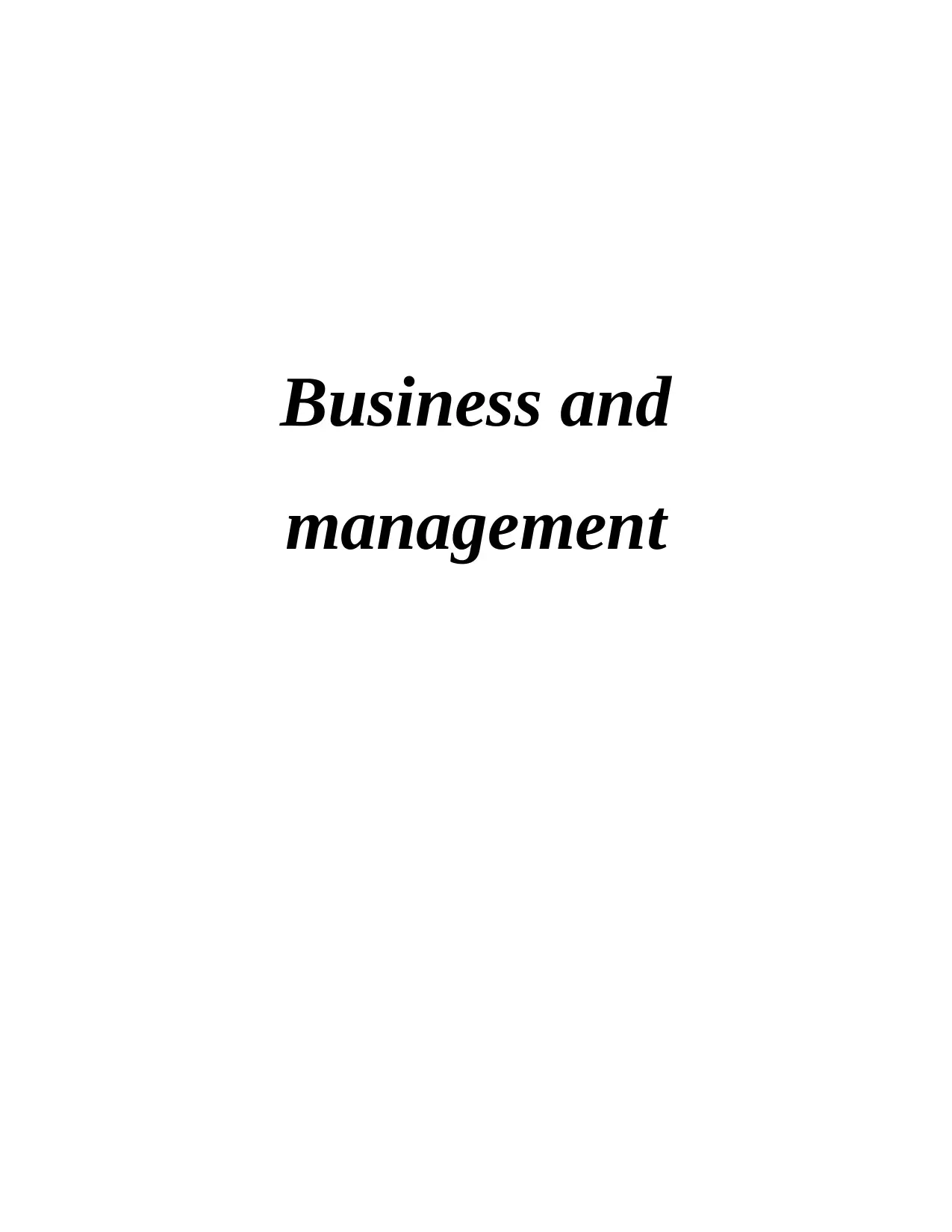
Business and
management
management
Paraphrase This Document
Need a fresh take? Get an instant paraphrase of this document with our AI Paraphraser
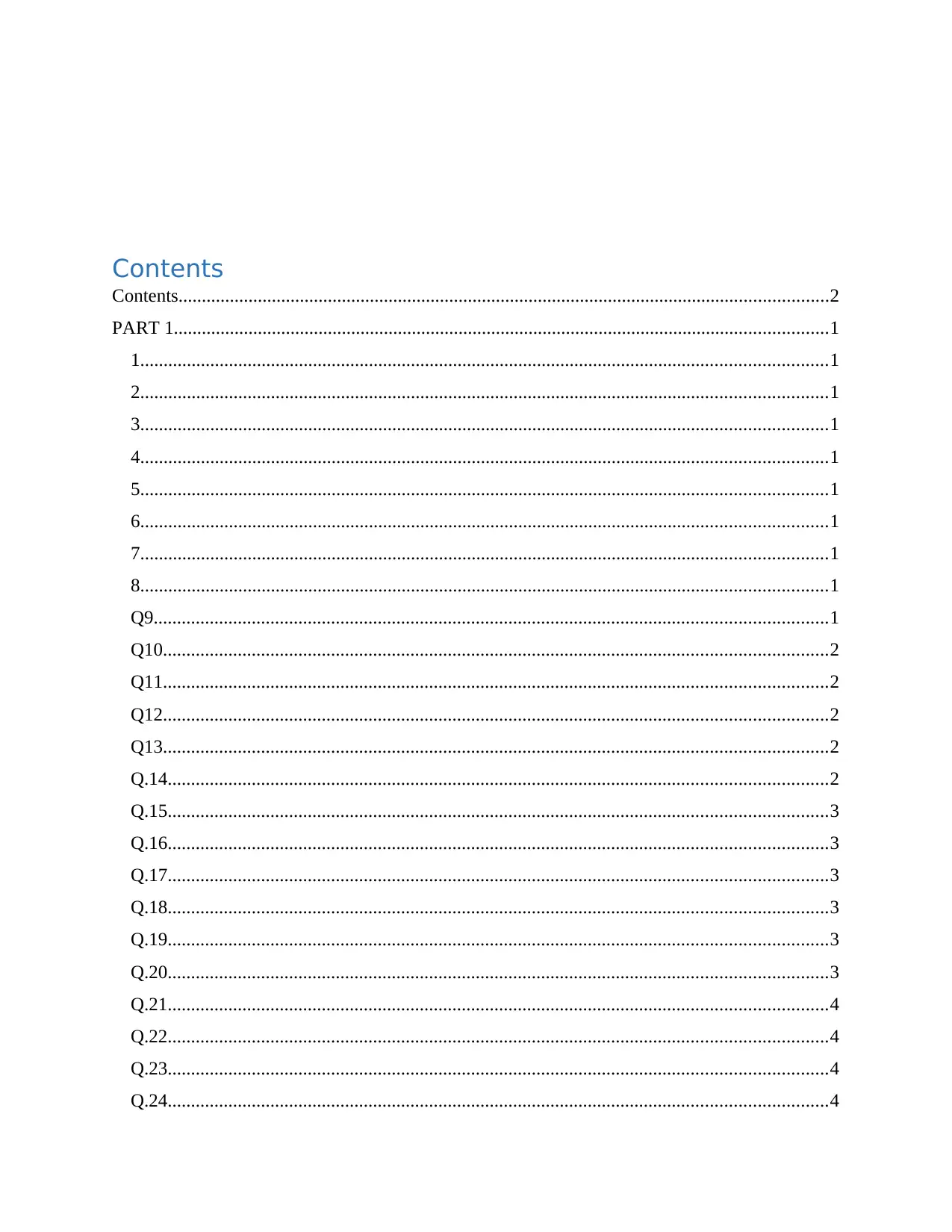
Contents
Contents...........................................................................................................................................2
PART 1............................................................................................................................................1
1...................................................................................................................................................1
2...................................................................................................................................................1
3...................................................................................................................................................1
4...................................................................................................................................................1
5...................................................................................................................................................1
6...................................................................................................................................................1
7...................................................................................................................................................1
8...................................................................................................................................................1
Q9................................................................................................................................................1
Q10..............................................................................................................................................2
Q11..............................................................................................................................................2
Q12..............................................................................................................................................2
Q13..............................................................................................................................................2
Q.14.............................................................................................................................................2
Q.15.............................................................................................................................................3
Q.16.............................................................................................................................................3
Q.17.............................................................................................................................................3
Q.18.............................................................................................................................................3
Q.19.............................................................................................................................................3
Q.20.............................................................................................................................................3
Q.21.............................................................................................................................................4
Q.22.............................................................................................................................................4
Q.23.............................................................................................................................................4
Q.24.............................................................................................................................................4
Contents...........................................................................................................................................2
PART 1............................................................................................................................................1
1...................................................................................................................................................1
2...................................................................................................................................................1
3...................................................................................................................................................1
4...................................................................................................................................................1
5...................................................................................................................................................1
6...................................................................................................................................................1
7...................................................................................................................................................1
8...................................................................................................................................................1
Q9................................................................................................................................................1
Q10..............................................................................................................................................2
Q11..............................................................................................................................................2
Q12..............................................................................................................................................2
Q13..............................................................................................................................................2
Q.14.............................................................................................................................................2
Q.15.............................................................................................................................................3
Q.16.............................................................................................................................................3
Q.17.............................................................................................................................................3
Q.18.............................................................................................................................................3
Q.19.............................................................................................................................................3
Q.20.............................................................................................................................................3
Q.21.............................................................................................................................................4
Q.22.............................................................................................................................................4
Q.23.............................................................................................................................................4
Q.24.............................................................................................................................................4
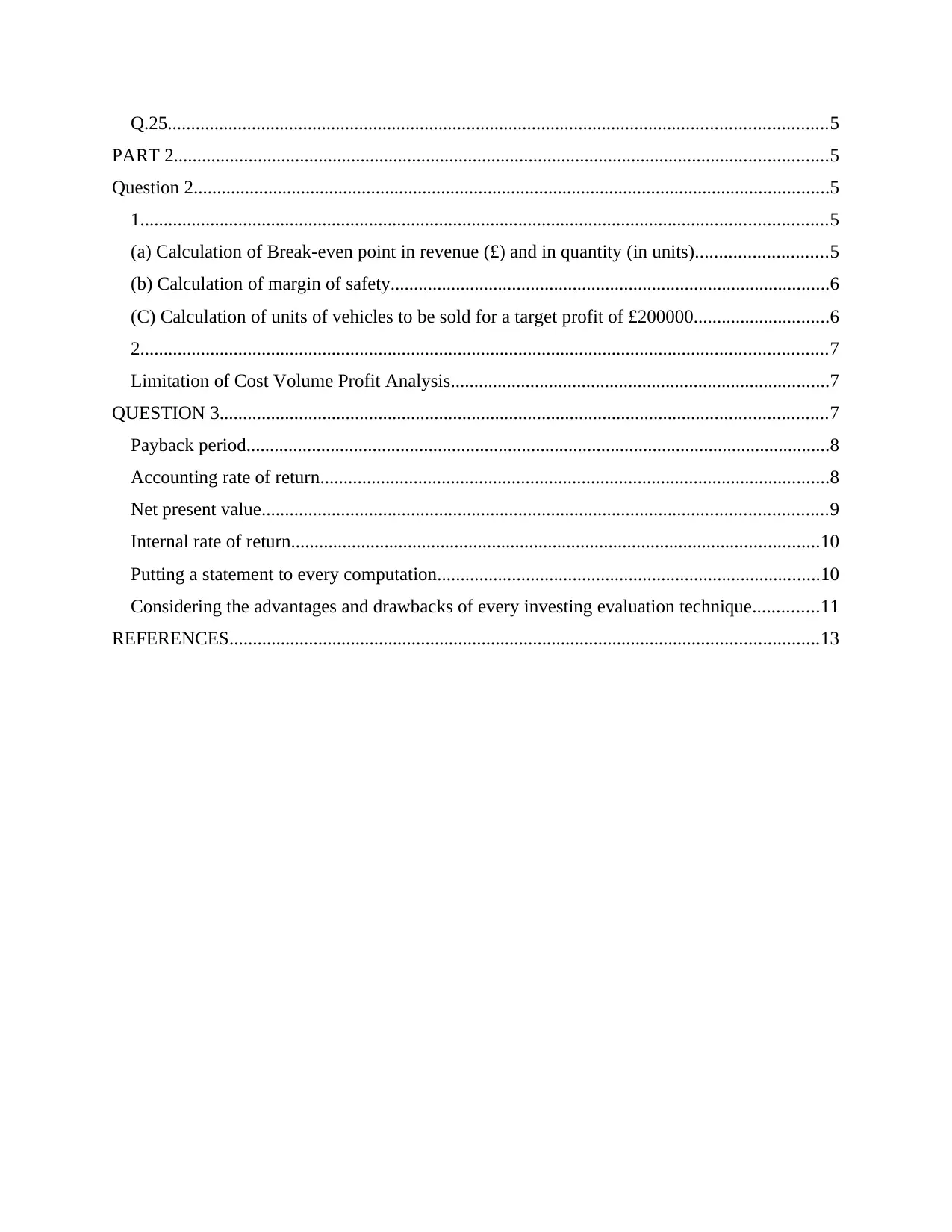
Q.25.............................................................................................................................................5
PART 2............................................................................................................................................5
Question 2........................................................................................................................................5
1...................................................................................................................................................5
(a) Calculation of Break-even point in revenue (£) and in quantity (in units)............................5
(b) Calculation of margin of safety..............................................................................................6
(C) Calculation of units of vehicles to be sold for a target profit of £200000.............................6
2...................................................................................................................................................7
Limitation of Cost Volume Profit Analysis.................................................................................7
QUESTION 3..................................................................................................................................7
Payback period.............................................................................................................................8
Accounting rate of return.............................................................................................................8
Net present value.........................................................................................................................9
Internal rate of return.................................................................................................................10
Putting a statement to every computation..................................................................................10
Considering the advantages and drawbacks of every investing evaluation technique..............11
REFERENCES..............................................................................................................................13
PART 2............................................................................................................................................5
Question 2........................................................................................................................................5
1...................................................................................................................................................5
(a) Calculation of Break-even point in revenue (£) and in quantity (in units)............................5
(b) Calculation of margin of safety..............................................................................................6
(C) Calculation of units of vehicles to be sold for a target profit of £200000.............................6
2...................................................................................................................................................7
Limitation of Cost Volume Profit Analysis.................................................................................7
QUESTION 3..................................................................................................................................7
Payback period.............................................................................................................................8
Accounting rate of return.............................................................................................................8
Net present value.........................................................................................................................9
Internal rate of return.................................................................................................................10
Putting a statement to every computation..................................................................................10
Considering the advantages and drawbacks of every investing evaluation technique..............11
REFERENCES..............................................................................................................................13
⊘ This is a preview!⊘
Do you want full access?
Subscribe today to unlock all pages.

Trusted by 1+ million students worldwide

Paraphrase This Document
Need a fresh take? Get an instant paraphrase of this document with our AI Paraphraser
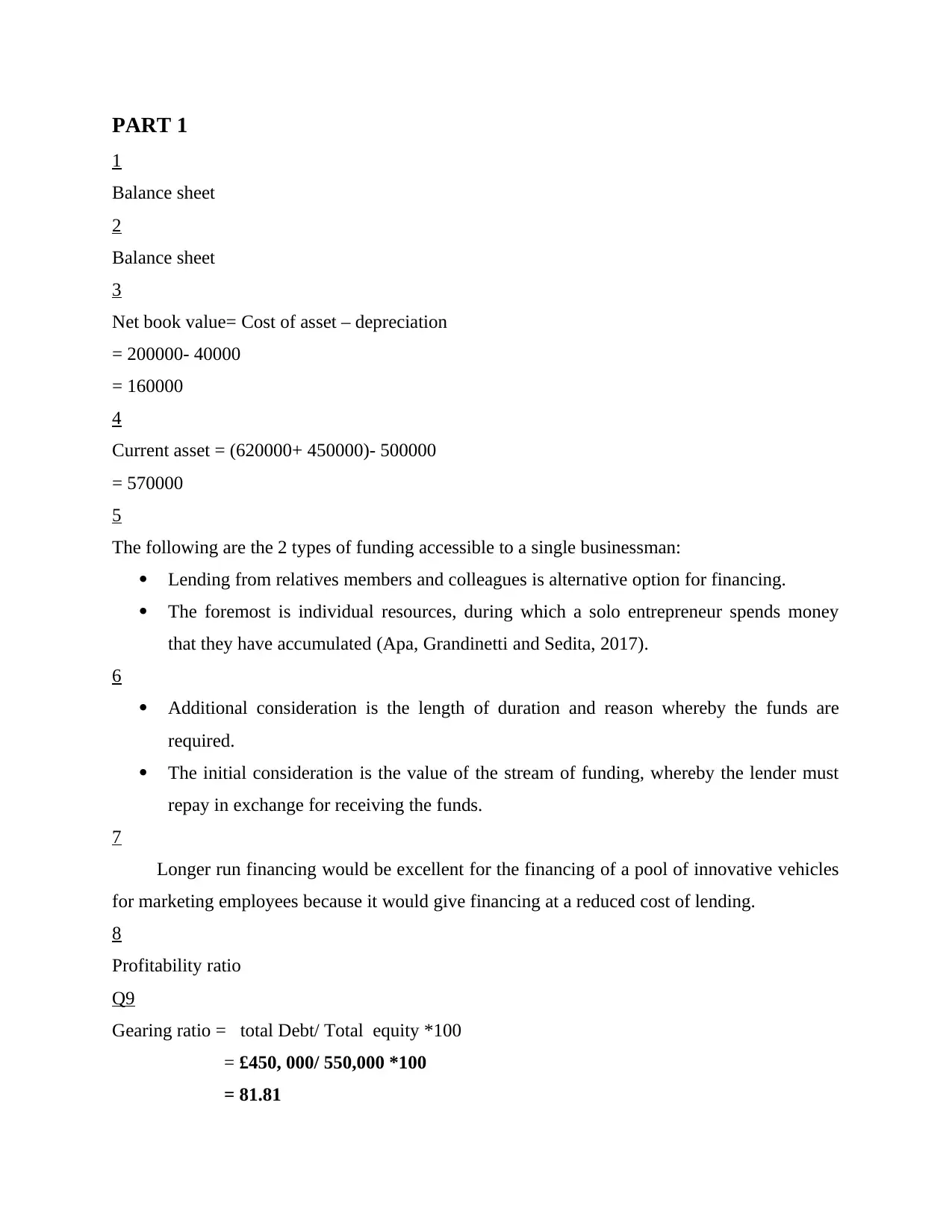
PART 1
1
Balance sheet
2
Balance sheet
3
Net book value= Cost of asset – depreciation
= 200000- 40000
= 160000
4
Current asset = (620000+ 450000)- 500000
= 570000
5
The following are the 2 types of funding accessible to a single businessman:
Lending from relatives members and colleagues is alternative option for financing.
The foremost is individual resources, during which a solo entrepreneur spends money
that they have accumulated (Apa, Grandinetti and Sedita, 2017).
6
Additional consideration is the length of duration and reason whereby the funds are
required.
The initial consideration is the value of the stream of funding, whereby the lender must
repay in exchange for receiving the funds.
7
Longer run financing would be excellent for the financing of a pool of innovative vehicles
for marketing employees because it would give financing at a reduced cost of lending.
8
Profitability ratio
Q9
Gearing ratio = total Debt/ Total equity *100
= £450, 000/ 550,000 *100
= 81.81
1
Balance sheet
2
Balance sheet
3
Net book value= Cost of asset – depreciation
= 200000- 40000
= 160000
4
Current asset = (620000+ 450000)- 500000
= 570000
5
The following are the 2 types of funding accessible to a single businessman:
Lending from relatives members and colleagues is alternative option for financing.
The foremost is individual resources, during which a solo entrepreneur spends money
that they have accumulated (Apa, Grandinetti and Sedita, 2017).
6
Additional consideration is the length of duration and reason whereby the funds are
required.
The initial consideration is the value of the stream of funding, whereby the lender must
repay in exchange for receiving the funds.
7
Longer run financing would be excellent for the financing of a pool of innovative vehicles
for marketing employees because it would give financing at a reduced cost of lending.
8
Profitability ratio
Q9
Gearing ratio = total Debt/ Total equity *100
= £450, 000/ 550,000 *100
= 81.81
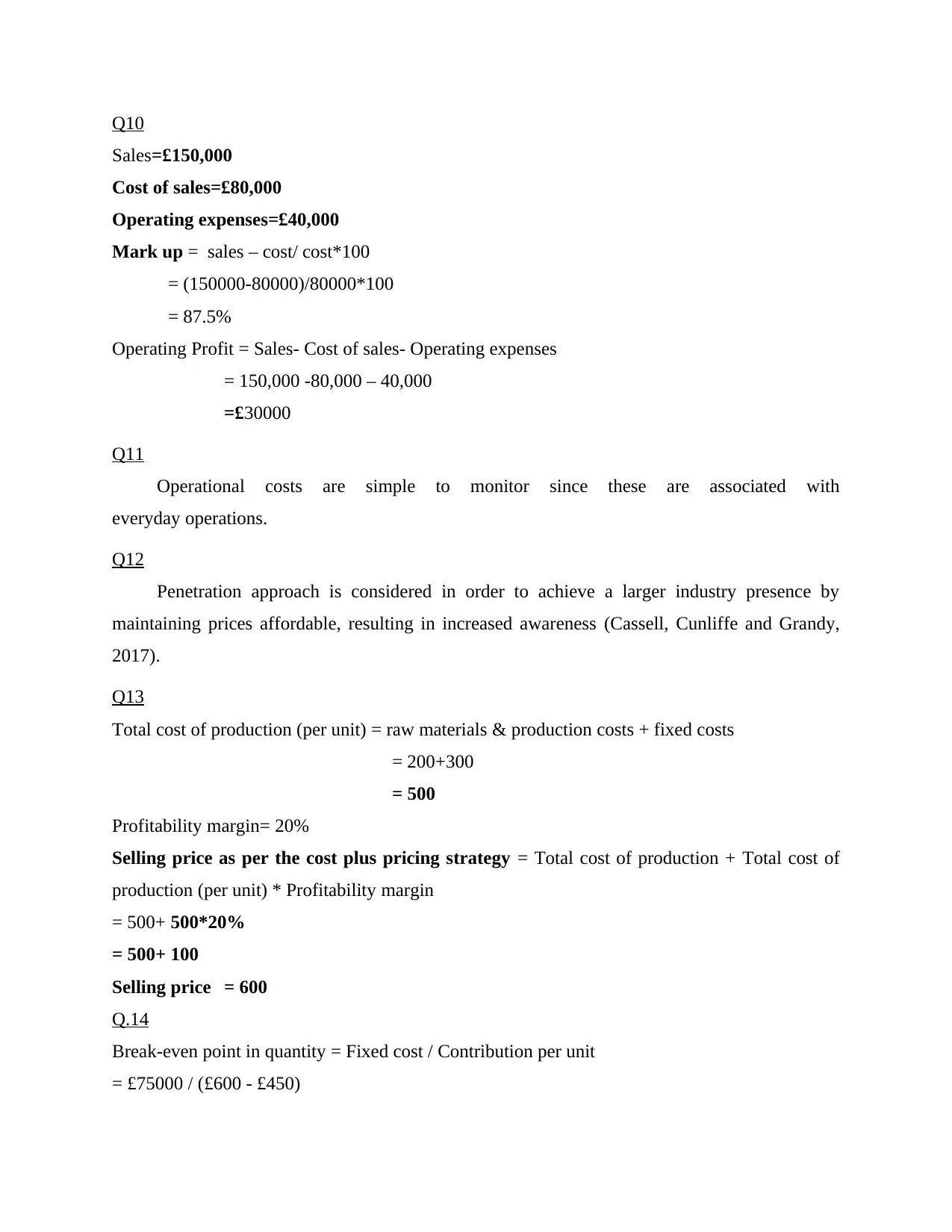
Q10
Sales=£150,000
Cost of sales=£80,000
Operating expenses=£40,000
Mark up = sales – cost/ cost*100
= (150000-80000)/80000*100
= 87.5%
Operating Profit = Sales- Cost of sales- Operating expenses
= 150,000 -80,000 – 40,000
=£30000
Q11
Operational costs are simple to monitor since these are associated with
everyday operations.
Q12
Penetration approach is considered in order to achieve a larger industry presence by
maintaining prices affordable, resulting in increased awareness (Cassell, Cunliffe and Grandy,
2017).
Q13
Total cost of production (per unit) = raw materials & production costs + fixed costs
= 200+300
= 500
Profitability margin= 20%
Selling price as per the cost plus pricing strategy = Total cost of production + Total cost of
production (per unit) * Profitability margin
= 500+ 500*20%
= 500+ 100
Selling price = 600
Q.14
Break-even point in quantity = Fixed cost / Contribution per unit
= £75000 / (£600 - £450)
Sales=£150,000
Cost of sales=£80,000
Operating expenses=£40,000
Mark up = sales – cost/ cost*100
= (150000-80000)/80000*100
= 87.5%
Operating Profit = Sales- Cost of sales- Operating expenses
= 150,000 -80,000 – 40,000
=£30000
Q11
Operational costs are simple to monitor since these are associated with
everyday operations.
Q12
Penetration approach is considered in order to achieve a larger industry presence by
maintaining prices affordable, resulting in increased awareness (Cassell, Cunliffe and Grandy,
2017).
Q13
Total cost of production (per unit) = raw materials & production costs + fixed costs
= 200+300
= 500
Profitability margin= 20%
Selling price as per the cost plus pricing strategy = Total cost of production + Total cost of
production (per unit) * Profitability margin
= 500+ 500*20%
= 500+ 100
Selling price = 600
Q.14
Break-even point in quantity = Fixed cost / Contribution per unit
= £75000 / (£600 - £450)
⊘ This is a preview!⊘
Do you want full access?
Subscribe today to unlock all pages.

Trusted by 1+ million students worldwide
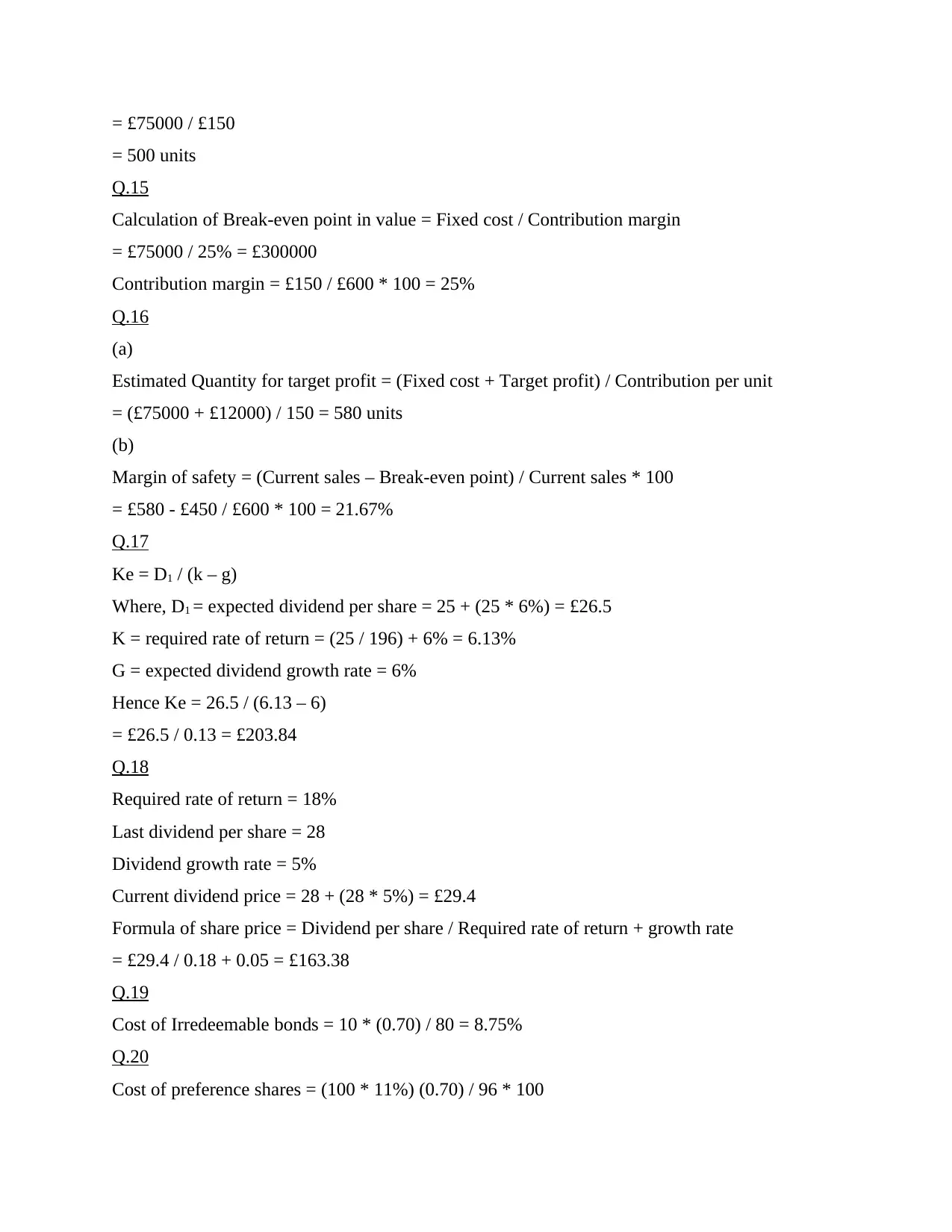
= £75000 / £150
= 500 units
Q.15
Calculation of Break-even point in value = Fixed cost / Contribution margin
= £75000 / 25% = £300000
Contribution margin = £150 / £600 * 100 = 25%
Q.16
(a)
Estimated Quantity for target profit = (Fixed cost + Target profit) / Contribution per unit
= (£75000 + £12000) / 150 = 580 units
(b)
Margin of safety = (Current sales – Break-even point) / Current sales * 100
= £580 - £450 / £600 * 100 = 21.67%
Q.17
Ke = D1 / (k – g)
Where, D1 = expected dividend per share = 25 + (25 * 6%) = £26.5
K = required rate of return = (25 / 196) + 6% = 6.13%
G = expected dividend growth rate = 6%
Hence Ke = 26.5 / (6.13 – 6)
= £26.5 / 0.13 = £203.84
Q.18
Required rate of return = 18%
Last dividend per share = 28
Dividend growth rate = 5%
Current dividend price = 28 + (28 * 5%) = £29.4
Formula of share price = Dividend per share / Required rate of return + growth rate
= £29.4 / 0.18 + 0.05 = £163.38
Q.19
Cost of Irredeemable bonds = 10 * (0.70) / 80 = 8.75%
Q.20
Cost of preference shares = (100 * 11%) (0.70) / 96 * 100
= 500 units
Q.15
Calculation of Break-even point in value = Fixed cost / Contribution margin
= £75000 / 25% = £300000
Contribution margin = £150 / £600 * 100 = 25%
Q.16
(a)
Estimated Quantity for target profit = (Fixed cost + Target profit) / Contribution per unit
= (£75000 + £12000) / 150 = 580 units
(b)
Margin of safety = (Current sales – Break-even point) / Current sales * 100
= £580 - £450 / £600 * 100 = 21.67%
Q.17
Ke = D1 / (k – g)
Where, D1 = expected dividend per share = 25 + (25 * 6%) = £26.5
K = required rate of return = (25 / 196) + 6% = 6.13%
G = expected dividend growth rate = 6%
Hence Ke = 26.5 / (6.13 – 6)
= £26.5 / 0.13 = £203.84
Q.18
Required rate of return = 18%
Last dividend per share = 28
Dividend growth rate = 5%
Current dividend price = 28 + (28 * 5%) = £29.4
Formula of share price = Dividend per share / Required rate of return + growth rate
= £29.4 / 0.18 + 0.05 = £163.38
Q.19
Cost of Irredeemable bonds = 10 * (0.70) / 80 = 8.75%
Q.20
Cost of preference shares = (100 * 11%) (0.70) / 96 * 100
Paraphrase This Document
Need a fresh take? Get an instant paraphrase of this document with our AI Paraphraser
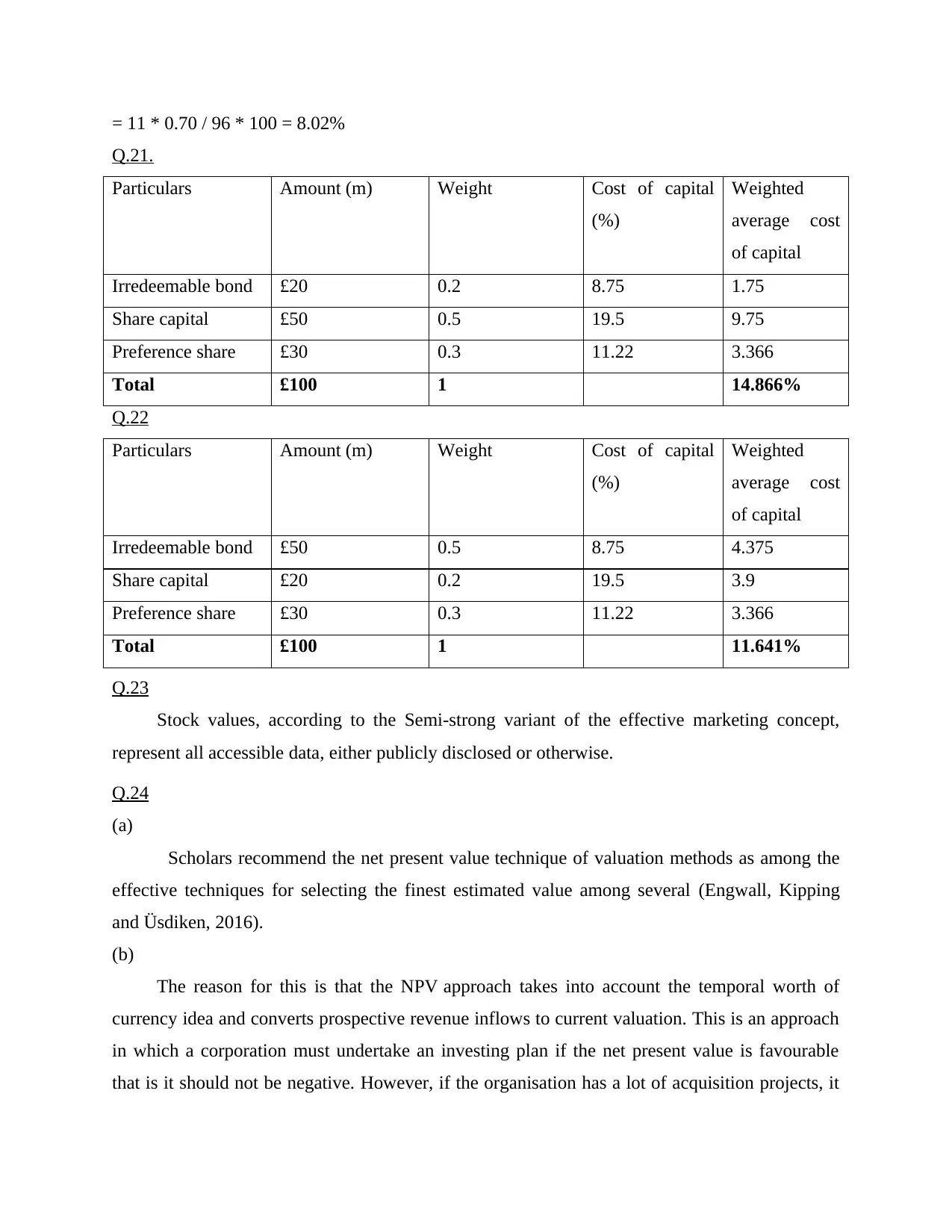
= 11 * 0.70 / 96 * 100 = 8.02%
Q.21.
Particulars Amount (m) Weight Cost of capital
(%)
Weighted
average cost
of capital
Irredeemable bond £20 0.2 8.75 1.75
Share capital £50 0.5 19.5 9.75
Preference share £30 0.3 11.22 3.366
Total £100 1 14.866%
Q.22
Particulars Amount (m) Weight Cost of capital
(%)
Weighted
average cost
of capital
Irredeemable bond £50 0.5 8.75 4.375
Share capital £20 0.2 19.5 3.9
Preference share £30 0.3 11.22 3.366
Total £100 1 11.641%
Q.23
Stock values, according to the Semi-strong variant of the effective marketing concept,
represent all accessible data, either publicly disclosed or otherwise.
Q.24
(a)
Scholars recommend the net present value technique of valuation methods as among the
effective techniques for selecting the finest estimated value among several (Engwall, Kipping
and Üsdiken, 2016).
(b)
The reason for this is that the NPV approach takes into account the temporal worth of
currency idea and converts prospective revenue inflows to current valuation. This is an approach
in which a corporation must undertake an investing plan if the net present value is favourable
that is it should not be negative. However, if the organisation has a lot of acquisition projects, it
Q.21.
Particulars Amount (m) Weight Cost of capital
(%)
Weighted
average cost
of capital
Irredeemable bond £20 0.2 8.75 1.75
Share capital £50 0.5 19.5 9.75
Preference share £30 0.3 11.22 3.366
Total £100 1 14.866%
Q.22
Particulars Amount (m) Weight Cost of capital
(%)
Weighted
average cost
of capital
Irredeemable bond £50 0.5 8.75 4.375
Share capital £20 0.2 19.5 3.9
Preference share £30 0.3 11.22 3.366
Total £100 1 11.641%
Q.23
Stock values, according to the Semi-strong variant of the effective marketing concept,
represent all accessible data, either publicly disclosed or otherwise.
Q.24
(a)
Scholars recommend the net present value technique of valuation methods as among the
effective techniques for selecting the finest estimated value among several (Engwall, Kipping
and Üsdiken, 2016).
(b)
The reason for this is that the NPV approach takes into account the temporal worth of
currency idea and converts prospective revenue inflows to current valuation. This is an approach
in which a corporation must undertake an investing plan if the net present value is favourable
that is it should not be negative. However, if the organisation has a lot of acquisition projects, it
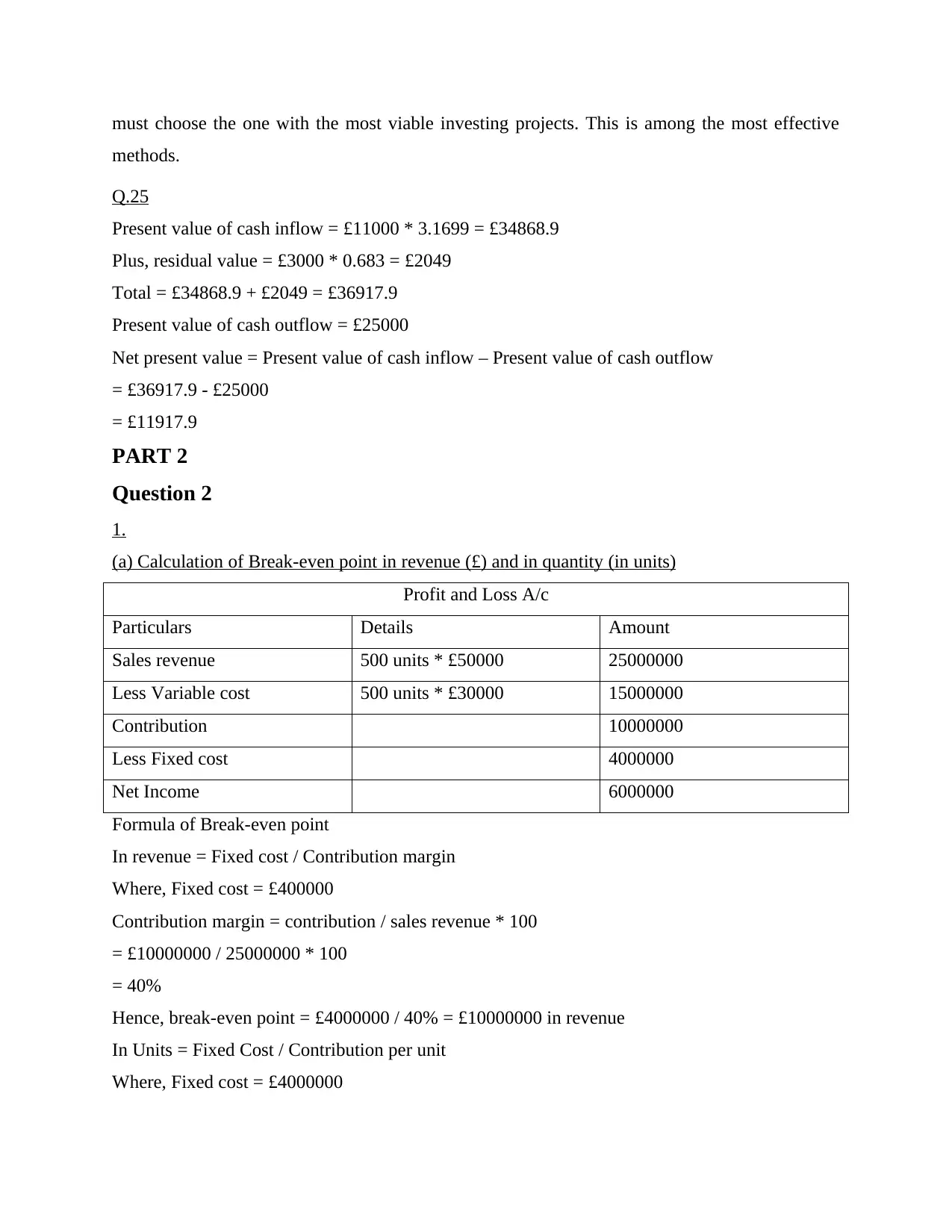
must choose the one with the most viable investing projects. This is among the most effective
methods.
Q.25
Present value of cash inflow = £11000 * 3.1699 = £34868.9
Plus, residual value = £3000 * 0.683 = £2049
Total = £34868.9 + £2049 = £36917.9
Present value of cash outflow = £25000
Net present value = Present value of cash inflow – Present value of cash outflow
= £36917.9 - £25000
= £11917.9
PART 2
Question 2
1.
(a) Calculation of Break-even point in revenue (£) and in quantity (in units)
Profit and Loss A/c
Particulars Details Amount
Sales revenue 500 units * £50000 25000000
Less Variable cost 500 units * £30000 15000000
Contribution 10000000
Less Fixed cost 4000000
Net Income 6000000
Formula of Break-even point
In revenue = Fixed cost / Contribution margin
Where, Fixed cost = £400000
Contribution margin = contribution / sales revenue * 100
= £10000000 / 25000000 * 100
= 40%
Hence, break-even point = £4000000 / 40% = £10000000 in revenue
In Units = Fixed Cost / Contribution per unit
Where, Fixed cost = £4000000
methods.
Q.25
Present value of cash inflow = £11000 * 3.1699 = £34868.9
Plus, residual value = £3000 * 0.683 = £2049
Total = £34868.9 + £2049 = £36917.9
Present value of cash outflow = £25000
Net present value = Present value of cash inflow – Present value of cash outflow
= £36917.9 - £25000
= £11917.9
PART 2
Question 2
1.
(a) Calculation of Break-even point in revenue (£) and in quantity (in units)
Profit and Loss A/c
Particulars Details Amount
Sales revenue 500 units * £50000 25000000
Less Variable cost 500 units * £30000 15000000
Contribution 10000000
Less Fixed cost 4000000
Net Income 6000000
Formula of Break-even point
In revenue = Fixed cost / Contribution margin
Where, Fixed cost = £400000
Contribution margin = contribution / sales revenue * 100
= £10000000 / 25000000 * 100
= 40%
Hence, break-even point = £4000000 / 40% = £10000000 in revenue
In Units = Fixed Cost / Contribution per unit
Where, Fixed cost = £4000000
⊘ This is a preview!⊘
Do you want full access?
Subscribe today to unlock all pages.

Trusted by 1+ million students worldwide
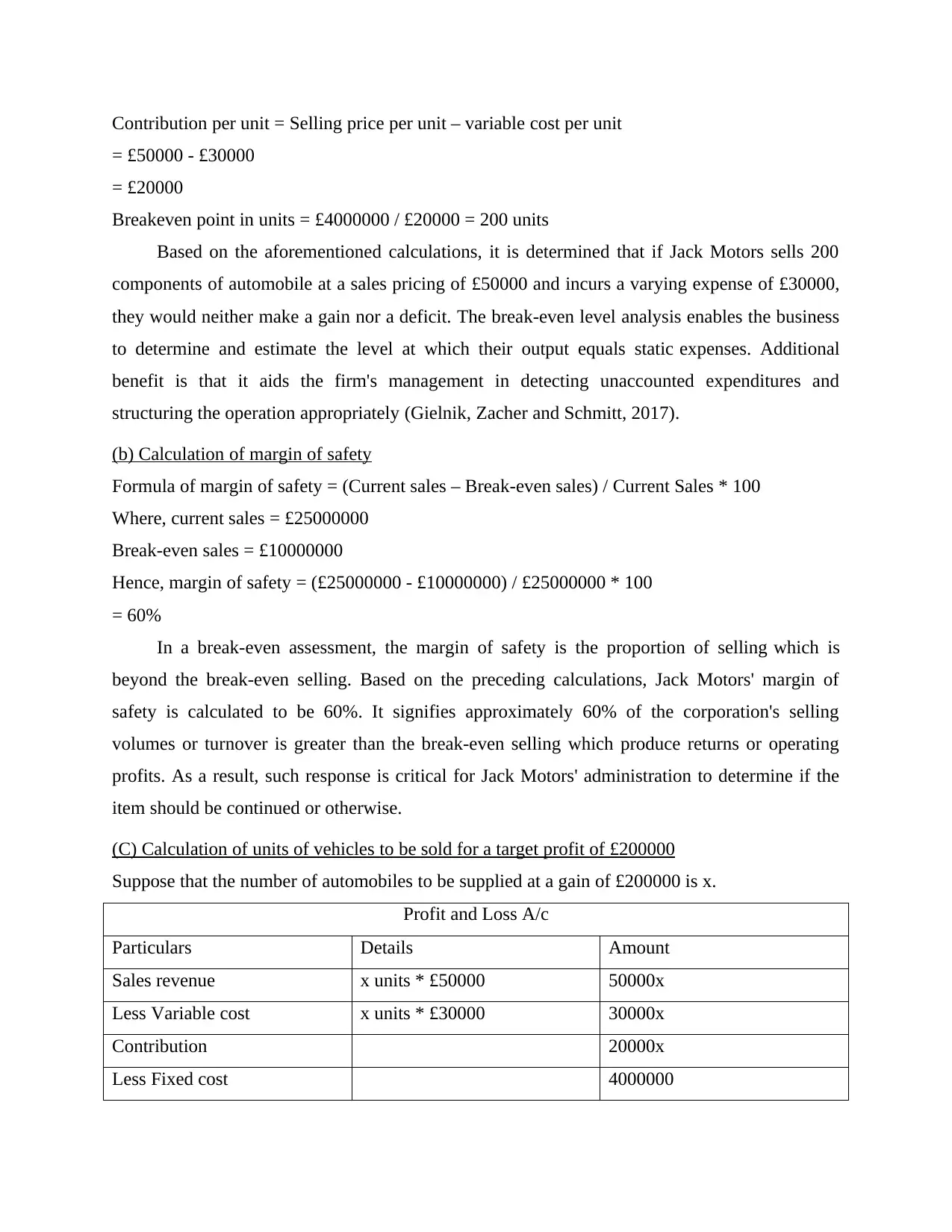
Contribution per unit = Selling price per unit – variable cost per unit
= £50000 - £30000
= £20000
Breakeven point in units = £4000000 / £20000 = 200 units
Based on the aforementioned calculations, it is determined that if Jack Motors sells 200
components of automobile at a sales pricing of £50000 and incurs a varying expense of £30000,
they would neither make a gain nor a deficit. The break-even level analysis enables the business
to determine and estimate the level at which their output equals static expenses. Additional
benefit is that it aids the firm's management in detecting unaccounted expenditures and
structuring the operation appropriately (Gielnik, Zacher and Schmitt, 2017).
(b) Calculation of margin of safety
Formula of margin of safety = (Current sales – Break-even sales) / Current Sales * 100
Where, current sales = £25000000
Break-even sales = £10000000
Hence, margin of safety = (£25000000 - £10000000) / £25000000 * 100
= 60%
In a break-even assessment, the margin of safety is the proportion of selling which is
beyond the break-even selling. Based on the preceding calculations, Jack Motors' margin of
safety is calculated to be 60%. It signifies approximately 60% of the corporation's selling
volumes or turnover is greater than the break-even selling which produce returns or operating
profits. As a result, such response is critical for Jack Motors' administration to determine if the
item should be continued or otherwise.
(C) Calculation of units of vehicles to be sold for a target profit of £200000
Suppose that the number of automobiles to be supplied at a gain of £200000 is x.
Profit and Loss A/c
Particulars Details Amount
Sales revenue x units * £50000 50000x
Less Variable cost x units * £30000 30000x
Contribution 20000x
Less Fixed cost 4000000
= £50000 - £30000
= £20000
Breakeven point in units = £4000000 / £20000 = 200 units
Based on the aforementioned calculations, it is determined that if Jack Motors sells 200
components of automobile at a sales pricing of £50000 and incurs a varying expense of £30000,
they would neither make a gain nor a deficit. The break-even level analysis enables the business
to determine and estimate the level at which their output equals static expenses. Additional
benefit is that it aids the firm's management in detecting unaccounted expenditures and
structuring the operation appropriately (Gielnik, Zacher and Schmitt, 2017).
(b) Calculation of margin of safety
Formula of margin of safety = (Current sales – Break-even sales) / Current Sales * 100
Where, current sales = £25000000
Break-even sales = £10000000
Hence, margin of safety = (£25000000 - £10000000) / £25000000 * 100
= 60%
In a break-even assessment, the margin of safety is the proportion of selling which is
beyond the break-even selling. Based on the preceding calculations, Jack Motors' margin of
safety is calculated to be 60%. It signifies approximately 60% of the corporation's selling
volumes or turnover is greater than the break-even selling which produce returns or operating
profits. As a result, such response is critical for Jack Motors' administration to determine if the
item should be continued or otherwise.
(C) Calculation of units of vehicles to be sold for a target profit of £200000
Suppose that the number of automobiles to be supplied at a gain of £200000 is x.
Profit and Loss A/c
Particulars Details Amount
Sales revenue x units * £50000 50000x
Less Variable cost x units * £30000 30000x
Contribution 20000x
Less Fixed cost 4000000
Paraphrase This Document
Need a fresh take? Get an instant paraphrase of this document with our AI Paraphraser
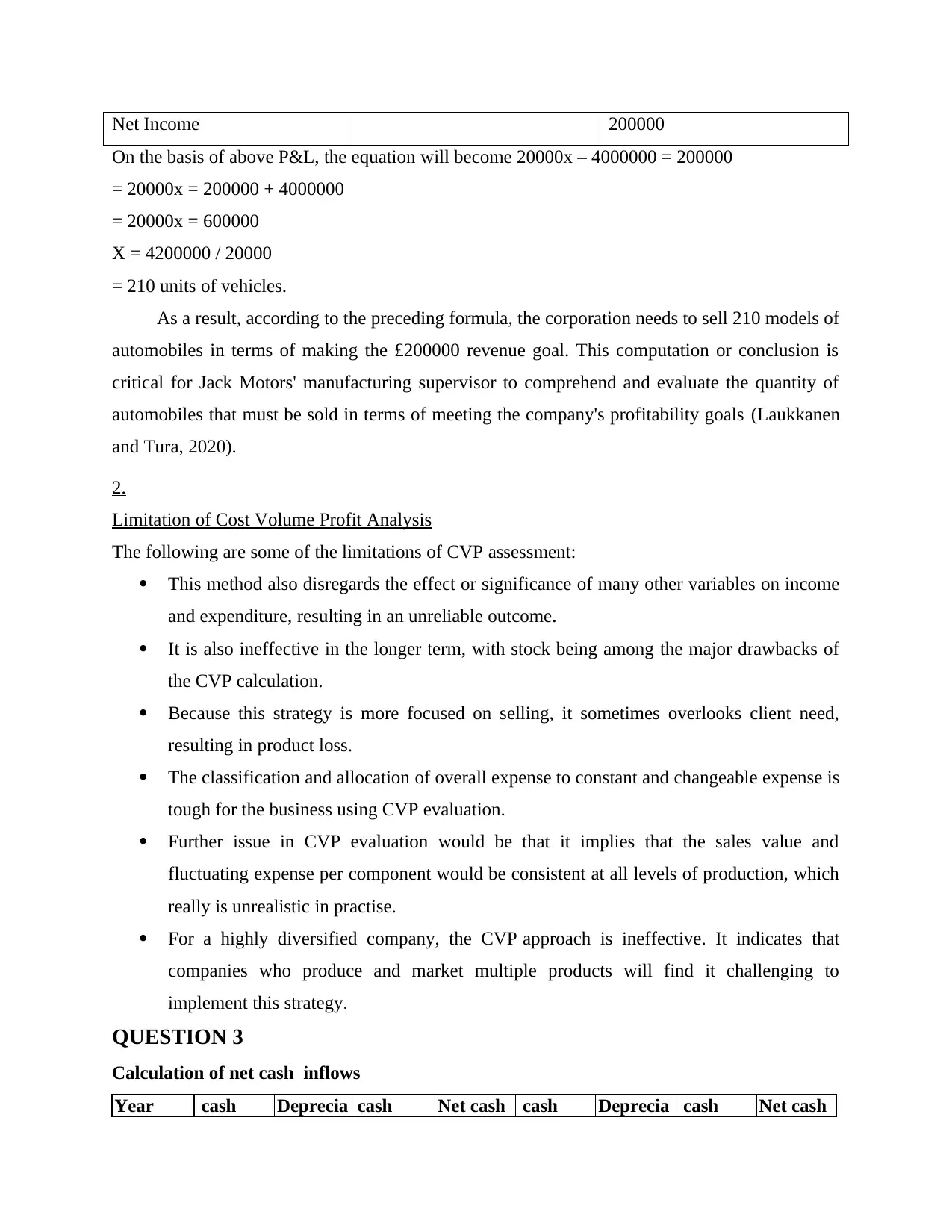
Net Income 200000
On the basis of above P&L, the equation will become 20000x – 4000000 = 200000
= 20000x = 200000 + 4000000
= 20000x = 600000
X = 4200000 / 20000
= 210 units of vehicles.
As a result, according to the preceding formula, the corporation needs to sell 210 models of
automobiles in terms of making the £200000 revenue goal. This computation or conclusion is
critical for Jack Motors' manufacturing supervisor to comprehend and evaluate the quantity of
automobiles that must be sold in terms of meeting the company's profitability goals (Laukkanen
and Tura, 2020).
2.
Limitation of Cost Volume Profit Analysis
The following are some of the limitations of CVP assessment:
This method also disregards the effect or significance of many other variables on income
and expenditure, resulting in an unreliable outcome.
It is also ineffective in the longer term, with stock being among the major drawbacks of
the CVP calculation.
Because this strategy is more focused on selling, it sometimes overlooks client need,
resulting in product loss.
The classification and allocation of overall expense to constant and changeable expense is
tough for the business using CVP evaluation.
Further issue in CVP evaluation would be that it implies that the sales value and
fluctuating expense per component would be consistent at all levels of production, which
really is unrealistic in practise.
For a highly diversified company, the CVP approach is ineffective. It indicates that
companies who produce and market multiple products will find it challenging to
implement this strategy.
QUESTION 3
Calculation of net cash inflows
Year cash Deprecia cash Net cash cash Deprecia cash Net cash
On the basis of above P&L, the equation will become 20000x – 4000000 = 200000
= 20000x = 200000 + 4000000
= 20000x = 600000
X = 4200000 / 20000
= 210 units of vehicles.
As a result, according to the preceding formula, the corporation needs to sell 210 models of
automobiles in terms of making the £200000 revenue goal. This computation or conclusion is
critical for Jack Motors' manufacturing supervisor to comprehend and evaluate the quantity of
automobiles that must be sold in terms of meeting the company's profitability goals (Laukkanen
and Tura, 2020).
2.
Limitation of Cost Volume Profit Analysis
The following are some of the limitations of CVP assessment:
This method also disregards the effect or significance of many other variables on income
and expenditure, resulting in an unreliable outcome.
It is also ineffective in the longer term, with stock being among the major drawbacks of
the CVP calculation.
Because this strategy is more focused on selling, it sometimes overlooks client need,
resulting in product loss.
The classification and allocation of overall expense to constant and changeable expense is
tough for the business using CVP evaluation.
Further issue in CVP evaluation would be that it implies that the sales value and
fluctuating expense per component would be consistent at all levels of production, which
really is unrealistic in practise.
For a highly diversified company, the CVP approach is ineffective. It indicates that
companies who produce and market multiple products will find it challenging to
implement this strategy.
QUESTION 3
Calculation of net cash inflows
Year cash Deprecia cash Net cash cash Deprecia cash Net cash
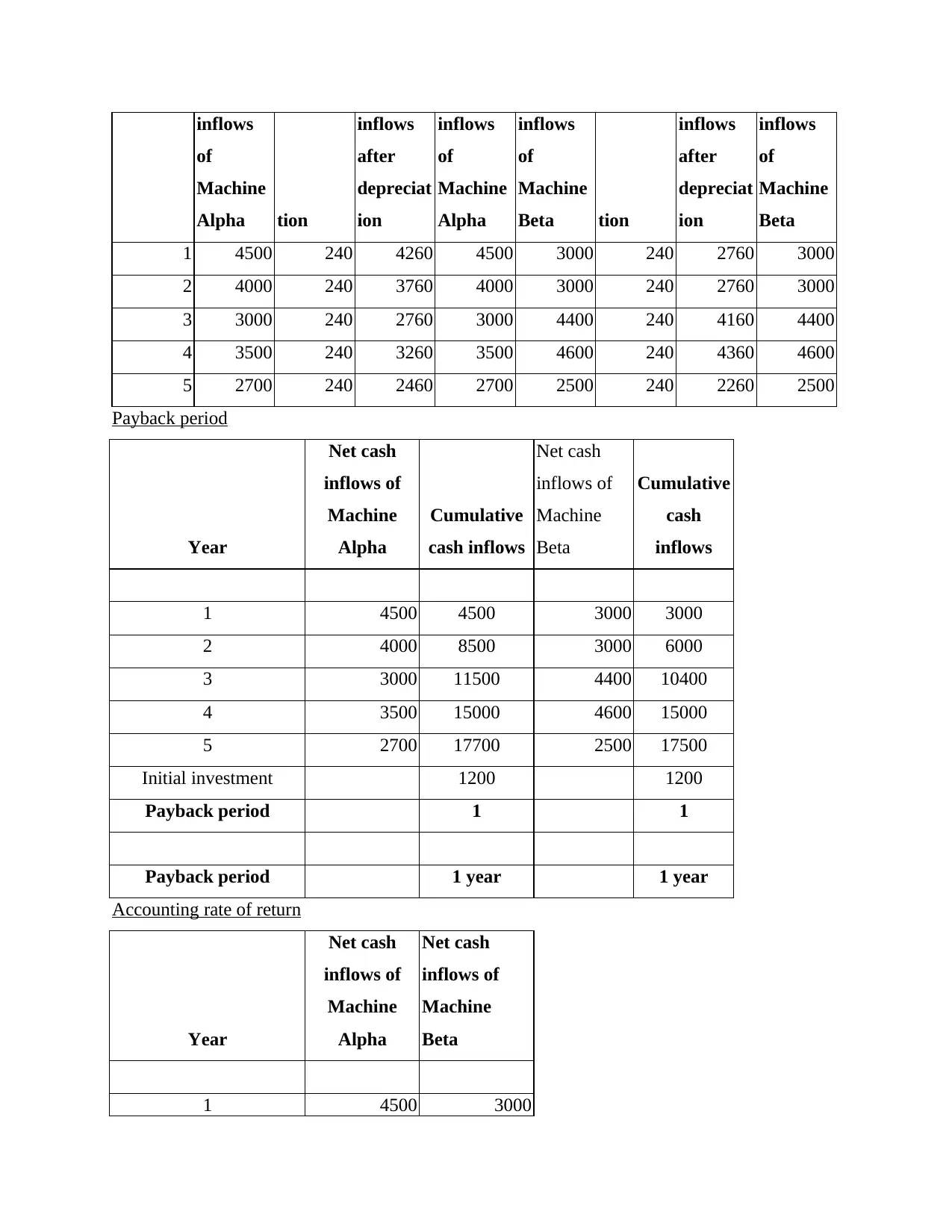
inflows
of
Machine
Alpha tion
inflows
after
depreciat
ion
inflows
of
Machine
Alpha
inflows
of
Machine
Beta tion
inflows
after
depreciat
ion
inflows
of
Machine
Beta
1 4500 240 4260 4500 3000 240 2760 3000
2 4000 240 3760 4000 3000 240 2760 3000
3 3000 240 2760 3000 4400 240 4160 4400
4 3500 240 3260 3500 4600 240 4360 4600
5 2700 240 2460 2700 2500 240 2260 2500
Payback period
Year
Net cash
inflows of
Machine
Alpha
Cumulative
cash inflows
Net cash
inflows of
Machine
Beta
Cumulative
cash
inflows
1 4500 4500 3000 3000
2 4000 8500 3000 6000
3 3000 11500 4400 10400
4 3500 15000 4600 15000
5 2700 17700 2500 17500
Initial investment 1200 1200
Payback period 1 1
Payback period 1 year 1 year
Accounting rate of return
Year
Net cash
inflows of
Machine
Alpha
Net cash
inflows of
Machine
Beta
1 4500 3000
of
Machine
Alpha tion
inflows
after
depreciat
ion
inflows
of
Machine
Alpha
inflows
of
Machine
Beta tion
inflows
after
depreciat
ion
inflows
of
Machine
Beta
1 4500 240 4260 4500 3000 240 2760 3000
2 4000 240 3760 4000 3000 240 2760 3000
3 3000 240 2760 3000 4400 240 4160 4400
4 3500 240 3260 3500 4600 240 4360 4600
5 2700 240 2460 2700 2500 240 2260 2500
Payback period
Year
Net cash
inflows of
Machine
Alpha
Cumulative
cash inflows
Net cash
inflows of
Machine
Beta
Cumulative
cash
inflows
1 4500 4500 3000 3000
2 4000 8500 3000 6000
3 3000 11500 4400 10400
4 3500 15000 4600 15000
5 2700 17700 2500 17500
Initial investment 1200 1200
Payback period 1 1
Payback period 1 year 1 year
Accounting rate of return
Year
Net cash
inflows of
Machine
Alpha
Net cash
inflows of
Machine
Beta
1 4500 3000
⊘ This is a preview!⊘
Do you want full access?
Subscribe today to unlock all pages.

Trusted by 1+ million students worldwide
1 out of 17
Related Documents
Your All-in-One AI-Powered Toolkit for Academic Success.
+13062052269
info@desklib.com
Available 24*7 on WhatsApp / Email
![[object Object]](/_next/static/media/star-bottom.7253800d.svg)
Unlock your academic potential
Copyright © 2020–2025 A2Z Services. All Rights Reserved. Developed and managed by ZUCOL.




